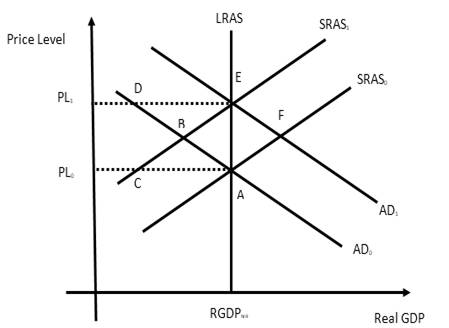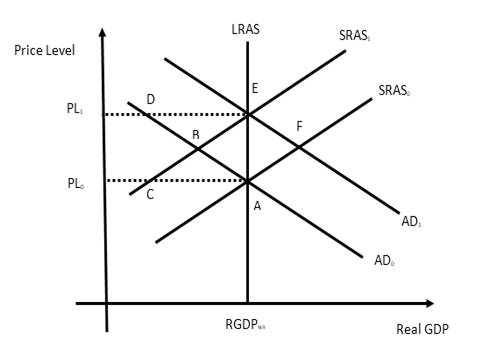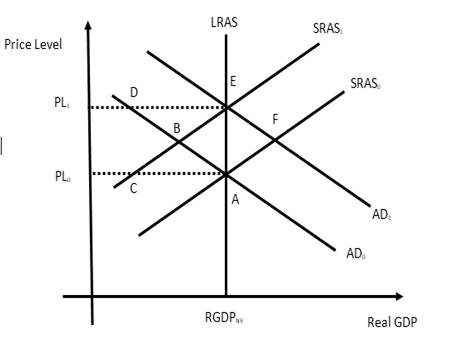
(a)
To indicate:
The movement that represents an unanticipated expansionary government policy in the short run.
Answer to Problem 3P
The movement of the equilibrium from point A to point F is due to an unanticipated expansionary government policy in the short run.
Explanation of Solution

The economy was in the initial equilibrium at point A with the intersection of AD0 and SARS0. At point A, the expected price level and the realized price level are same at PL0. The equilibrium output RGDPNR is the also on the long-run
Now, suppose the government wants to lower the
As the expansionary fiscal policy is implemented, the aggregate demand curve shifts from AD0 to AD1with no corresponding shift in the short run aggregate supply curve due to unanticipated nature of the fiscal policy. A new equilibrium is established at point F in the short run.
Expansionary government policy:
The government policies that cause the aggregate demand of the economy to rise and thereby induce production and income along with the generation of employment is referred as the expansionary government policy. The tools used by the government for this purpose
(b)
To indicate:
The movement that represents an unanticipated contractionary government policy in the short run.
Answer to Problem 3P
The movement from equilibrium point F to equilibrium point A represents the unanticipated contractionary government policy.
Explanation of Solution

The economy is in the long run equilibrium at point A with real GDP, RGDPNR and price level PL0. The economy is described by the aggregate demand curve AD0 and short-run
To bring back stability to the economy, government takes measures that shifts the aggregate demand curve to the left to its original position, which is only possible when the government pursues a contractionary fiscal policy. However, if the contractionary fiscal policy is unanticipated, the public will maintain its expectation about the price level and therefore, the short run aggregate supply curve will remain unaffected. A contractionary fiscal policy affects the aggregate demand by lowering it from its current level for all prices and thereby shifting the aggregate demand curve back from AD1to AD0. With no change in the position of the short run aggregate supply curve due to the unanticipated nature of the policy, the shift in the aggregate demand curve will being the economy back to the old equilibrium at point A from point F.
Contractionary government policy:
The government policies that cause the aggregate demand of the economy to fall and thereby discourages production and generation of income along with employment is referred as contractionary government policy. The tools used by the government for this purpose are taxation and government expenditure. For the contractionary purpose, the government may either raise the tax rate or lower its expenditure or both. Contractionary government policy, also called contractionary fiscal policy, help the economy control inflation by lowering the circulation of money in the economy.
(c)
To indicate:
The movement that represents an anticipated expansionary government policy under the rational expectations.
Answer to Problem 3P
The movement from point A to point E represents completely anticipated expansionary government policy under rational expectations.
Explanation of Solution

When an expansionary fiscal policy is completely anticipated, public by virtue of rational expectation will know from before that there will be a rise in the price level due to the policy. They immediately revise their activities and thereby changes the position of the short-run aggregate supply curve. Labor will revise their wages upwards; household will revise its spending; producers will lower production due to rising cost and so on which will shift SRAS0to SRAS1 even before the policy comes into effect creating a new short run equilibrium point at R. As the expansionary policy is implemented, the shift in the aggregate demand curve from AD0to AD1 generates the long run equilibrium at point F, where the economy is in the long run potential level of output with a higher price level.
Expansionary government policy:
The government policies that cause the aggregate demand of the economy to rise and thereby induce production and income along with the generation of employment is referred as the expansionary government policy. The tools used by the government for this purpose taxation and government expenditure. For the expansionary purpose, the government may either lower the tax rate or increase its expenditure or both. Expansionary government policy, also called expansionary fiscal policy, can help the economy move out of a recessionary situation.
Rational expectations:
People make decisions based on three primary factors, namely human rationality, available information, and experiences. The theory of rational expectation suggests that the current expectation of people can influence the future state of the economy.
(d)
To indicate:
The movement that represents an anticipated contractionary government policy in the short-run.
Answer to Problem 3P
The movement from point E to point F represents completely anticipated contractionary government policy in the short run.
Explanation of Solution

Suppose the economy is in long-run equilibrium at point E. At this point, the government plans a contractionary fiscal policy. If the move is completely anticipated, public will know from before that a contractionary fiscal policy will lower the price level. They will immediately revise their activities and that will cause the short run supply curve to shift rightwards from SRAS1 to SRAS0 even before the policy is implemented. Thus, the economy will move to a new short run equilibrium at point F.
Contractionary government policy:
The government policies that cause the aggregate demand of the economy to fall and thereby discourages production and generation of income along with employment is referred as contractionary government policy. The tools used by the government for this purpose are taxation and government expenditure. For the contractionary purpose, the government may either raise the tax rate or lower its expenditure or both. Contractionary government policy, also called contractionary fiscal policy, help the economy control inflation by lowering the circulation of money in the economy.
(e)
To explain:
The result of a situation where an expansionary government policy is made, but the inflationary effects of this policy is less than expected.
Answer to Problem 3P
If the expansionary fiscal policy results in the less than expected inflation, it will inhibit the growth in output and employment.
Explanation of Solution

The expansionary fiscal policy boosts the aggregate demand which in turn puts an upward pressure on the price level. The rising price level encourages businesses to expand production level and generate income and employment. However, in case the fiscal policy fails to create the desired level of inflation, it will generate less impetus for the businesses to produce more and thereby inhibit the growth of output and employment.
Expansionary government policy:
The government policies that cause the aggregate demand of the economy to rise and thereby induce production and income along with the generation of employment is referred as the expansionary government policy. The tools used by the government for this purpose taxation and government expenditure. For the expansionary purpose, the government may either lower the tax rate or increase its expenditure or both. Expansionary government policy, also called expansionary fiscal policy, can help the economy move out of a recessionary situation.
Want to see more full solutions like this?
- Our macroeconomic model suggests that after a decline in aggregate demand like that of 2007, the economy will self correct and return to a position where the GDP gap is zero. If this is correct, why should the government ever intervene with fiscal policy? a. It take many years for the GDP gap to close on its own. b. This is part of the government's "mission statement" as given in the Constitution. c. Fiscal policy is profitable for banks. d. People do not trust the theory behind the model.arrow_forwardSuppose the US Federal Government decides to increase its spending without issuing debt by raising additional taxes (i.e., tax-financed government spending). Which of the following statements describes how tax-financed government spending affects real GDP over the short run and the long run? Real GDP rises above the natural level in the short run, but it falls below the natural level in the long run. Real GDP remains at the natural level in both the short run and the long run. Real GDP falls below the natural level in the short run, but it rises above the natural level in the long run. Real GDP rises above the natural level in both the short run and the long run.arrow_forwardConsider the Laffer Curve. Why does government revenue drop to the right of T∗? (A) People work fewer hours, avoid taxes, or leave the country. (B) The government becomes less efficient at tax collection due to government failure. (C) Markets that are charged higher taxes incur more Deadweight Loss. (D) “Our new Constitution is now established, and has an appearance that promises permanency; but in this world nothing can be said to be certain, except death andarrow_forward
- If Canada's economy moves into an expansionary phase of the business cycle, then: Group of answer choices A. government spending and tax revenue will increase because of automatic stabilizers. B.government spending and tax revenue will decrease because of automatic stabilizers. C.automatic stabilizers will decrease government spending and increase tax revenue. D.automatic stabilizers will increase government spending and decrease tax revenue.arrow_forwardHow do the instances when expansionary fiscal policy should be used compare with those for contractionary fiscal policy? Expansionary fiscal policy should be used during recessions to help build the economy and contractionary fiscal policy should be used when there is high inflation. Expansionary fiscal policy should be used to increase government revenue and contractionary fiscal policy should be used to increase consumer spending. Expansionary fiscal policy should be used to combat high inflation and contractionary fiscal policy should be used to increase government revenue. Expansionary fiscal policy should be used to decrease the unemployment rate and contractionary fiscal policy should be used when economic growth is too fast.arrow_forwardWhich statement below is true of ONLY fiscal policy? Uses government expenditures to create demand Increases the availability of money Used to alter AD A policy typically set by a banking authority Explain it correctly. But not copy paste from the anywherearrow_forward
- QUESTION 5 05. The "crowding-out secondary effect expansionary macroeconomic policy a) For fiscal policy it is about government borrowing to finance the government budget deficit, associated with expansionary fiscal policy. This increased government borrowing tends to increase the market rate of interest, which dampens investment spending. b) For monetary policy it is about the expansion of the economy increasing the demand for money to service the increased volume of transactions. This tends to increase the market rate of interest, which dampens investment spending. c) Decreases the autonomous spending multiplier and thus the impact of expansionary policy. d) All of the above.arrow_forwardExplain the concept of automatic stabilizers in fiscal policy and how they function during economic downturns.A) Automatic stabilizers are government policies that always lead to economic stability.B) Automatic stabilizers are government programs like unemployment benefits and progressive taxation that automatically kick in during economic downturns to provide support and stabilize the economy.C) Automatic stabilizers are monetary policies implemented by the central bank to control inflation.D) Automatic stabilizers have no relevance in fiscal policy.arrow_forwardSuppose actual real GDP is $7.91 trillion, potential real GDP is $13.33 trillion, the marginal propensity to consume is 0.68, and that the government has a balanced budget. If we ignore price effects, by how many trillions of dollars should the government change its spending to fix the gap while keeping the federal budget balanced? (Round this to two digits after the decimal and enter this value as either a positive value or a negative value without the dollar sign.)arrow_forward
- "Fine-tuning" the economy is not possible for the United States and generally large economies governed by a democratic political system because... a) Often it takes economists up to 6 months to determine with confidence that the economy changed its trajectory towards recession or expansion. This is the "recognition lag." b) The policies of the Federal Reserve must be approved by Congress which takes a long time. c) It takes the political system (Congress and the President) several months and sometimes years to agree on specific fiscal policies to change the economy's direction. This is the "policy lag." d) It may take considerable time to implement fiscal policy, especially if the policy involves significant new spending programs, as takes many months to set up new administration, policies, procedures and hire the requisite administrators. This is the "implementation or administrative lag." e) The policies passed by Congress must be approved by the Supreme Court. f) Fiscal policy…arrow_forwardExplain the concept of automatic stabilizers in fiscal policy and how they function during economic downturns. A) Automatic stabilizers refer to government policies that always lead to economic stability. B) Automatic stabilizers are government programs like unemployment benefits and progressive taxation that automatically kick in during economic downturns to provide support and stabilize the economy. C) Automatic stabilizers are monetary policies implemented by the central bank to control inflation. D) Automatic stabilizers have no relevance in fiscal policy.arrow_forwardwhat type(s) of stimulus policy can account for an increase in interest rates and an increase in output?Explain and include a well-labeled figure.arrow_forward
 Exploring EconomicsEconomicsISBN:9781544336329Author:Robert L. SextonPublisher:SAGE Publications, Inc
Exploring EconomicsEconomicsISBN:9781544336329Author:Robert L. SextonPublisher:SAGE Publications, Inc Economics: Private and Public Choice (MindTap Cou...EconomicsISBN:9781305506725Author:James D. Gwartney, Richard L. Stroup, Russell S. Sobel, David A. MacphersonPublisher:Cengage Learning
Economics: Private and Public Choice (MindTap Cou...EconomicsISBN:9781305506725Author:James D. Gwartney, Richard L. Stroup, Russell S. Sobel, David A. MacphersonPublisher:Cengage Learning Macroeconomics: Private and Public Choice (MindTa...EconomicsISBN:9781305506756Author:James D. Gwartney, Richard L. Stroup, Russell S. Sobel, David A. MacphersonPublisher:Cengage Learning
Macroeconomics: Private and Public Choice (MindTa...EconomicsISBN:9781305506756Author:James D. Gwartney, Richard L. Stroup, Russell S. Sobel, David A. MacphersonPublisher:Cengage Learning Economics (MindTap Course List)EconomicsISBN:9781337617383Author:Roger A. ArnoldPublisher:Cengage Learning
Economics (MindTap Course List)EconomicsISBN:9781337617383Author:Roger A. ArnoldPublisher:Cengage Learning






